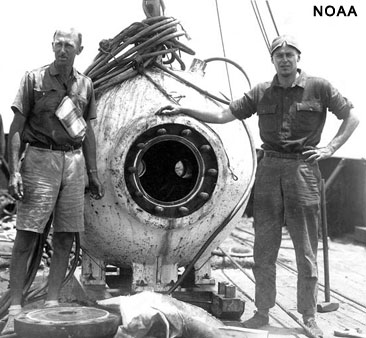William
Beebe and the Bathysphere
Exploration of the sea was a trend
that had begun in earnest with the landmark findings of the Challenger
expedition. The scientific study of the ocean had become a legitimate
endeavor and came to be known as oceanography. In the years since the
ambitious charter and success of the Challenger, scientists continued
to dredge and trawl through the midwater ranges to gather specimens
for study and identification. Many scientists began to grow increasingly
frustrated with the limitations of this kind of sampling, feeling certain
they were missing a great deal more than their slow and blindly prodding
nets could retrieve. One scientist working for the New York Zoological
Society, who was amongst the frustrated scientific community, made the
ingenious and risky leap from sampling blindly with nets to visiting
and observing the deep. William Beebe pioneered the very first deep
ocean, manned submersible that was capable of taking an observer down
into the darkness and crushing depths of the deep ocean.
Just barely big enough inside for
two men, the bathysphere (as it came it be called) was a spherical steel
ball with inch and a half thick walls. It was fitted with a heavy steel
door that had to be bolted on, and had a single, round window about
6 inches across and three inches thick, that observers could use to
peer into the strange living world of the deep. The bathysphere reached
depths of over half a mile down by being lowered on a cable, making
the trips down below especially dangerous. Having no maneuvering thrusters
or steering controls made the bathysphere vulnerable to the pitching
and rolling actions of the ship to which it was tethered. It took a
strong stomach and incredible bravery for Beebe and his associated to
make those early deep sea dives. But for the very first time ever, human
eyes were able to observe the organisms that inhabited the still and
lightless world of the deep. Aided by a powerful floodlight fixed to
the outside of the bathysphere, William Beebe saw incredible creatures
alive and darting about in their own habitat. . He had no sophisticated
cameras to be able to take photographs of what he saw during his dives,
so he reported details of his observations to an artist who reconstructed
some of the ghastly creatures he saw in illustrations.
One of the most remarkable phenomena
that he observed that is characteristic of most creatures living in
the darkness of midwater were incredible displays of light produced
from within the bodies of living organisms. Now known as bioluminescence,
Beebe was astounded by the sheer numbers of creatures exhibiting this
tendency to display their own light – in a world of perpetual
darkness the language of survival was spoken in flashes of light.
In the years that the bathysphere
made its numerous dives off the coast of Florida Beebe and his team
identified new species never before brought to the light of day. Not
only did they conduct the most comprehensive examination of deep sea
life in a concentrated area for that time, Beebe’s observations
during his descents in the bathysphere contributed a completely new
perspective to the study of life in the deep. Beebe’s first hand
accounts and illustrations of the incredible diversity and even delicate
nature of the life he observed in the deep reinforced the fact that
the crude dredges and trawls were missing most of the real action. The
best way to study life in the deep is to observe it in its own habitat.
The Trieste
->


